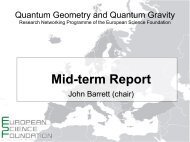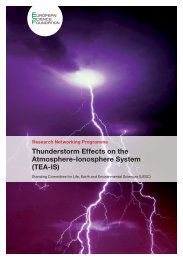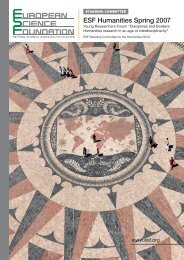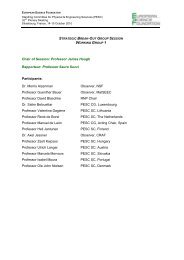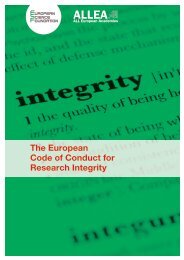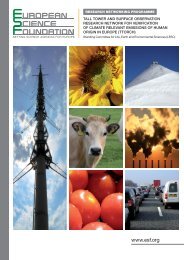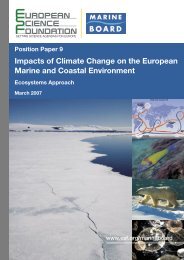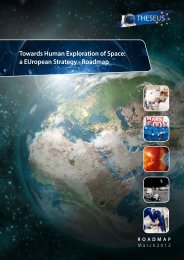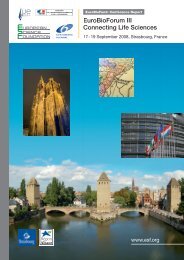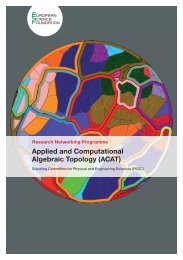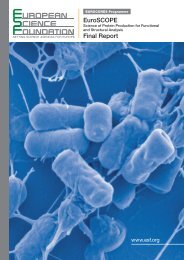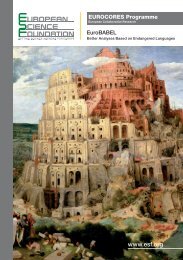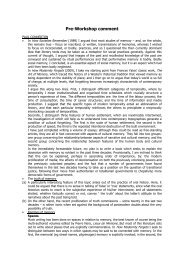European Peer Review Guide - European Science Foundation
European Peer Review Guide - European Science Foundation
European Peer Review Guide - European Science Foundation
Create successful ePaper yourself
Turn your PDF publications into a flip-book with our unique Google optimized e-Paper software.
22<br />
<strong>European</strong> <strong>Peer</strong> <strong>Review</strong> <strong>Guide</strong><br />
• For the sake of transparency, it is advisable to<br />
inform the applicants of the general statistics on<br />
submission, e.g., overall numbers received versus<br />
eligible proposals, etc.<br />
4.3.3 Resubmissions<br />
In some organisations, particularly for larger programmes,<br />
the eligibility checks do not immediately<br />
lead to non-compliance and exclusion of the proposals.<br />
In these situations, there may be a period of<br />
feedback and negotiation between the office and<br />
the applicants during which the ineligible applications<br />
are provided the opportunity to improve their<br />
proposals and to resubmit. This practice, if necessary,<br />
should be handled with great care, openly and<br />
diligently by competent and experienced members<br />
of the staff in order to avoid personal influences and<br />
inconsistencies. In these cases it is crucial to be fully<br />
transparent and consistent in applying known and<br />
clear criteria and in providing equitable opportunities<br />
and attention to all applicants consistently and<br />
to the same degree.<br />
In most cases, however, the eligibility checks<br />
are final and determining, without the possibility<br />
of resubmission in the current call. For these<br />
situations, it is also necessary to be clear on the<br />
possibilities and means of resubmitting improved<br />
proposals in the next round of the call for proposals.<br />
4.4 Selection and allocation<br />
of experts<br />
One of the most important and challenging phases<br />
of the peer review process is to collect the required<br />
number of willing and available experts who would<br />
agree to conduct the task of expert assessments both<br />
as individual/remote reviewers and/or members of<br />
panels and committees as described below.<br />
The activities to be undertaken for typical programmes<br />
are grouped under the following four<br />
steps (Figure 6).<br />
4.4.1 Identification of the types of experts<br />
needed<br />
Depending on the nature of the programme and the<br />
adopted peer review model, different types of expert<br />
referees and evaluators may be required. For example,<br />
there are instruments for which peer review is<br />
conducted by remote experts only. However, for<br />
the majority of the instruments both remote and<br />
panel review are used. Therefore it is first necessary<br />
to consider the types of experts needed. Evidently,<br />
this process should start in the preparatory phase,<br />
but be implemented during this phase.<br />
Means of identification of expert reviewers<br />
Funding organisations often have a database of<br />
reviewers which is structured based on a given and<br />
often multi-level research classification system (taxonomy<br />
of research profiles). As discussed below, with<br />
the advent of increasingly more advanced information<br />
management systems and tools, the original<br />
need for conventional multi-level classification systems<br />
may be reconsidered now. Currently, however,<br />
most of the existing operational systems across different<br />
science management organisations seem to rely<br />
on some kind of hierarchical structuring of research<br />
profiles in terms of disciplines and sub-disciplines.<br />
The peer review survey shows that 90% of the<br />
organisations use a multi-level research classification<br />
system for the structuring of their research profiles<br />
and proposals. The results of the survey point to a<br />
strong tendency to rely on internal sources for the<br />
definition of these classification systems: for example,<br />
50% of respondents rely on their organisation’s<br />
staff; 39% on their scientific council, while 28.6% of<br />
the organisations use the system offered by the OECD<br />
Frascati Manual 21. The data collected through the<br />
ESF Survey suggests that the current classification<br />
systems in place may not be fully compatible. To<br />
move towards more comparable and therefore more<br />
widely accepted common peer review practices, it is<br />
crucial that the peer reviewers are assigned scientific/<br />
expert profiles that can be interpreted clearly and<br />
without ambiguity across different organisations<br />
and their databases.<br />
Furthermore, detailed analysis of the survey data<br />
suggests that those organisations that have indicated<br />
using the OECD Frascati Manual as the basis<br />
of their classification system have by and large also<br />
been more satisfied with the effectiveness of their<br />
classification system; this is in contrast to those that<br />
use internally defined classification systems22.<br />
Therefore, the use of commonly accepted systems<br />
such as the OECD Frascati Manual or of any other<br />
classification system that allows a unique mapping<br />
of the research profiles from one system into<br />
another without ambiguity should be encouraged;<br />
21. See <strong>European</strong> <strong>Science</strong> <strong>Foundation</strong> (2010b), ESF Survey Analysis<br />
Report on <strong>Peer</strong> <strong>Review</strong> Practices, in particular Section 3.1, Question<br />
11: “Does your organisation use a research classification system<br />
for the grouping of your proposals?” (Table 3.1) and Question<br />
12: “What is the source of this classification?” (Figure 3.1). See<br />
also Appendix B to the Report: Research Classification System: A<br />
preliminary map of existing <strong>European</strong> approaches.<br />
22. See <strong>European</strong> <strong>Science</strong> <strong>Foundation</strong> (2010b), ESF Survey Analysis<br />
Report on <strong>Peer</strong> <strong>Review</strong> Practices, Section 3.1, §3.1.4, Table 3.3.



